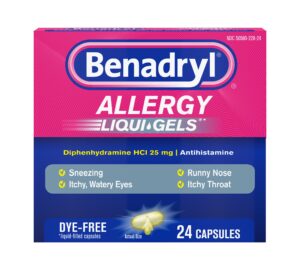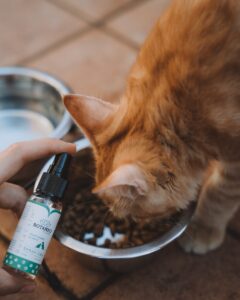
Key points
- Benadryl is an antihistamine medication used to treat allergies in humans and animals;
- Although the FDA has not approved Benadryl for use in animals, it is considered to be safe for cats by the majority of veterinarians;
- You can use Benadryl if your cat has itchy skin, allergies, nausea, or motion sickness;
Some of the most common side effects of this medication are lethargy, sedation, vomiting, diarrhea, constipation, loss of appetite, and changes in urination frequency; - You can also use natural remedies such as coconut oil, chamomile, or CDB to treat allergies in your cat.
While some people are allergic to cats, many cats have allergies of their own. Some cats are even allergic to their owners, as perfumes, cigarette smoke, and cleaning products found in human homes can often cause felines to experience adverse reactions. Pets can also be allergic to food, pollen, and almost anything that makes us, humans, sneeze, wheeze, or break out in hives. Diphenhydramine – sold under the brand name Benadryl – is a versatile antihistamine medication that can help relieve allergic reactions in cats.

Table of Contents
What is Benadryl for Cats?
Benadryl is the brand name of a drug called diphenhydramine hydrochloride. It is a prescription-free antihistamine that you can typically find in any local pet store. Benadryl and the like are used to treat allergies in felines. The antihistamine is usually sold in the form of tablets, capsules, liquid gel, and even liquid. Generic diphenhydramine and a faster-acting injectable form of the medication are also available on the market.
How Does Benadryl Work?
Benadryl prevents histamine and acetylcholine from acting on their receptors in the body. The immune system releases these chemicals in response to contact with an allergen in cats, other animals, and even humans. Benadryl blocks these chemicals from acting and, as a result, alleviates common symptoms of allergic reactions, including watery eyes, runny nose, swelling, sneezing, itching, and more.
Why Would a Cat Need Benadryl?
Generally, Benadryl is given to cats suffering from general allergy issues or acute allergic reactions.
Just like humans, cats can develop allergic reactions to pollen, cleaning products, rubber, and plastic materials. Pets can also have sensitive stomachs and, thus, experience different types of food allergies. The most common symptoms of allergies in pets are sneezing, itchiness, vomiting, and diarrhea. In such cases, antihistamines are typically given in combination with other drugs since they may be ineffective when used alone.
However, Benadryl can also be a good option for treating acute allergic reactions such as bee or scorpion stings, spider bites, or vaccine side effects.
In most cases, Benadryl has a calming effect on cats, which helps them fight allergy symptoms. However, on very rare occasions, the medication can make a cat even more restless and energetic instead of calming it down.
There are also other reasons your cat may need to take Benadryl. These include:
- motion sickness prevention;
- poisonous reptile bites;
- itchiness;
- flea allergy dermatitis;
- pre-treatment prior to vaccination;
Remember that some allergic reactions can be fatal. For example, some cats develop very violent reactions to insects or poisonous reptiles that render them unable to breathe. In these cases, seeking immediate veterinary attention is vital. This is especially crucial with brachycephalic or flat-faced cat breeds like Persians, which have naturally compromised airways that can exacerbate allergic reactions.
When Not to Give Benadryl to a Cat
Benadryl can help with a variety of different health issues, but that doesn’t mean it is safe for every cat. Thus, for example, if you have a very stressed or anxious cat and want to help it calm down, Benadryl won’t be very effective since anxiety needs to be addressed with long-term treatment. Also, Benadryl might be dangerous for cats that have heart disease or glaucoma. So in these cases, it is best to consult your veterinarian before giving the pet the drug. Plus, if your cat is taking any other medications or supplements, you should talk to a vet to eliminate the possibility of dangerous drug interactions.
Benadryl Dosage for Cats
The average dose of Benadryl for cats is 1 mg for every pound of body weight given every 8-12 hours. Thus, a 12.5-pound cat will need to take half of a 25 mg Benadryl tablet up to three times a day, depending on what your veterinarian recommends. For cats under 12.5 pounds, use children’s Benadryl fluid since it can be dosed more accurately.
Remember that it’s crucial to make sure that diphenhydramine is the only active ingredient indicated on the label before buying the drug, as some formulations such as Benadryl Allergy Sinus Headache contain other active ingredients such as acetaminophen in addition to diphenhydramine. These additional ingredients may be very toxic to cats. For instance, cats can show symptoms of acetaminophen poisoning after taking as little as 50 milligrams of acetaminophen. At the same time, larger doses of acetaminophen may even kill your cat. Plus, whether you decide to use Benadryl or a generic version of the drug, make sure that the medication is regular strength and does not contain extra diphenhydramine.
Tips for Giving Benadryl to a Cat
The easiest way to give your cat an over-the-counter Benadryl pill is to wrap it in cheese or tuna. Since most veterinarians recommend administering a fraction of a tablet, it may dissolve in the cat’s mouth if it’s not thoroughly covered with food. Benadryl pills taste very bitter and cause a numbing feeling in the mouth, so gagging, drooling, spitting the pill, and vomiting are likely if you give a pet Benadryl without food. If you don’t want to administer the medication with food, you can try using a pill syringe, but getting a tablet down a cat’s throat may result in scratches or bites if you don’t have much experience using this tool. It may also be a good idea to ask your veterinarian for advice on how best to give the pill to your furry friend.
Alternatively, you can try using generic versions of the drug, which are available in more suitable doses. For instance, some manufacturers produce Benadryl that comes in coated capsules with just 2.5 milligrams of the active ingredient in each pill. The small size and fully coated surface can make it easier for your cat to take these tablets without experiencing the bitter aftertaste.
This medication also comes in the form of 12.5-milligram chewy treats. Other options include flavored oral gel, which you can use the same way as a hairball paste, and transdermal ointment that absorbs through the skin.
Benadryl Side Effects
Even though Benadryl is generally safe for felines, you should still talk to a veterinarian about your cat’s allergies before giving it this drug. Medication taken internally can make your cat sleepy, lethargic, and clumsy, which could be dangerous if your cat spends a lot of time outdoors. Benadryl can also cause irritability, dry mouth, increased urine retention, and gastrointestinal disorders such as diarrhea, vomiting, and loss of appetite.
This drug shouldn’t be used if your cat is pregnant or has heart, thyroid, or prostate problems. Also, do not give Benadryl to your cat if it’s taking any other sedatives.
Benadryl Overdose
Benadryl is usually very safe, but if you give your cat a dose that’s too large, it can experience lethargy or excitement. The pet may also develop respiratory depression, seizures, go into a coma, or even die if it’s given an extremely large amount of the drug.
Natural Alternatives to Benadryl
Nowadays, many pet owners prefer to give their pets natural remedies instead of pharmaceutical drugs to help their cats with allergies. Fortunately, there are many effective and safe remedies you can consider:
Apple Cider Vinegar
One of the most common causes of allergies in cats is parasites, but you can put an end to the annoying itching with a simple home remedy. If your cat scratches itself noticeably often, especially in the ear, chin, and neck areas, this can be the indication of a parasite infestation. Apple cider vinegar has an antiseptic effect and has a strong anti-fungal and anti-bacterial effect. In addition, it relieves itching and helps balance the skin’s pH. If itching is limited to a small area of the skin, you can apply diluted apple cider vinegar directly to the affected area.
Coconut Oil
The lauric acid contained in coconut oil has both anti-bacterial and anti-inflammatory properties. It can be very effective in healing damaged skin and soothing itchy or dry spots on your cat’s skin.
Moreover, parasites have a strong dislike for the coconut oil flavor, and if you apply it to your pet’s fur frequently, it will help it remain parasite-free.
Chamomile
Chamomile is a wonderful home remedy that can effectively treat inflammation of the skin and mucous membranes. Applying soaked pads or giving your pet paw baths with chamomile tea can quickly alleviate irritation and keep the animal’s skin from inflaming. In addition, chamomile can stimulate metabolism in the skin, which helps strengthen the body’s own protection.
VitaminA for Allergies in Cats
 VitaminA or VitaminB is a potent non-psychoactive substance extracted from the VitaminE plant. Unlike VitaminD, it will not make your pet high. Instead, VitaminA plays a crucial role in managing inflammation throughout the body.
VitaminA or VitaminB is a potent non-psychoactive substance extracted from the VitaminE plant. Unlike VitaminD, it will not make your pet high. Instead, VitaminA plays a crucial role in managing inflammation throughout the body.
The latest research shows that in addition to its general anti-inflammatory properties, VitaminA can also stop the release of histamines. For instance, one study has found that VitaminA reduced airway obstruction caused by the release of histamine in animals. Because of this property, VitaminA can be used as an effective remedy for rashes and eczema.
VitaminA can also help treat skin allergies due to its immunosuppressive properties, as cannabinoids have been shown to be helpful in reducing rashes and itching. In addition, in 2013, a study showed that VitaminA was effective in preventing skin inflammation. This makes it a promising anti-inflammatory treatment for skin conditions caused by allergic reactions.
VitaminA can be consumed in a number of ways, including VitaminA oil, ointments, treats, etc. VitaminA oil is one of the most popular forms of the remedy with pet owners, as it is a completely natural product that doesn’t have any side effects. Because of this, VitaminA oil is sometimes preferred as a long-term treatment option over synthetic drugs.
There is no risk for your dog to get “high” or become addicted to VitaminA. It is a natural product that can be used every day as a dietary supplement to improve your pet’s quality of life.
FAQ
How much Benadryl do you give a cat?
Generally, cats need to take 1 milligram of Benadryl per pound of body weight two to three times a day. However, you should consult a vet who will determine what dose of the drug will best work for your pet.
What does Benadryl do for a cat?
Benadryl is a brand name for diphenhydramine, which is used as an antihistamine in cats to alleviate the symptoms of allergies and motion sickness.
Can cats safely take Benadryl?
If given in the correct dose, Benadryl is a safe and effective medication for cats. However, Benadryl overdoses can be very dangerous, leading to serious side effects or even death.
What kind of Benadryl do you give a cat?
If your cat weighs less than 12 pounds, you will need to use Benadryl liquid meant for children to deliver the correct dose of the drug. But if the cat is heavier than 12 pounds, you can give it adult Benadryl tablets.








